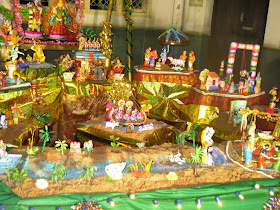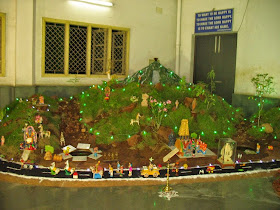I made a very nice posting during the 2013 Navaratri Function of the significance of Kolu (Tamil=Golu: means “Divine Presence”) displays during the Navaratri Festival, see this link here. In this respect at that time, I visited the house of a Priest family of the Arunachaleswarar Temple to view their Kolu display and it was those photographs that I posted in the above link.
This year I am posting photographs of the very elaborate, beautiful Kolu display at the ashram of Yogi Ramsuratkumar. If you are hereabouts, do visit the Kolu display, its really quite lovely. So much time and attention has been spent in creating beautiful displays of legends and leelas of Gods and Goddesses.
Kolu figurines can be simple or very complicated and based upon Gods and Saints, depictions of the Epics and Puranas (i.e. Mahabharata, Ramayana, Krishna Leelas etc.), Demigods and National leaders, marriage occasions, musical instruments, shops, current affairs and scenes from everyday life; such as shops, bus stop, cars, street scenes etc.
Historically Kolu had a significant connection with the agricultural economy of Ancient India. In order to encourage de-silting of irrigation canals the Kolu celebration was aimed at providing demand for clay that was needed for the celebratory dolls. It is believed that the tradition of Kolu has been in existence from the reign of the Vijayanagara kings.
There are several sections at the Yogi Ramsuratkumar Ashram within the Kolu displays depicting the abodes, live and legends of various Gods and Goddesses.
One section is of Lord Shiva and has beautiful models with figurines of our own Arunachala, the Amaranath snow lingam and dancing Lord Shiva at Kailash.
 |
| Amaranath Snow Lingam |
 |
| Mount Kailash and Dancing Shiva |
Another section is of the Ramayana with models depicting various parts of the legend.
 |
| Section on the Ramayana |
 |
| Section shows some of the tales and stories of Rama and Sita |
There is a very special section dedicated to the 6 abodes of Lord Murugan.
Those six abodes are:
Thirupparamkunram: Located on the outskirts of Madurai on a hillock where Kartikeya married Indra's daughter Deivanai.
Tiruchendur: Located on the sea-shore near Tuticorin. The Temple commemorates the place where Murugan worshiped Lord Siva and won a decisive victory over demon Soorapadman.
Palani: Located south east of Coimbatore, the Temple is build on a hill top where Murugan resided after his feud with his family over a divine fruit.
Swamimalai: Located at 5 km from Kumbakonam, the Temple is built on an artificial hill and . commemorates the incident where Lord Murugan explained the essence of "Om" to his father Lord Siva.
Thiruthani: Located near Chennai, Murugan reclaimed his inner peace after waging a war with Asuras and married Valli here.
Pazhamudircholai: Located on the outskirts of Madurai on a hillock with a holy stream nearby called "Nupura Gangai".
 |
| Section dedicated to Lord Murugan |
The person assigned to the Lord Krishna section has done an amazing work in depicting various leelas from the legends surrounding Lord Krishna.
 |
| Section full of Krishna leelas and legends |
 |
| With two nice butter BalaKrishnas |
Another section is of the Yogi Ramsuratkumar Ashram.
 |
| Beautiful wooden model of the Ashram Hall |
 |
| Yogi Samisthan |
 | |
| Road back of Yogi Samisthan |
 |
| First night of Kolu Display |
All these photographs were taken on the first night of the 2014 Navaratri Kolu Display at Yogi Ramsuratkumar Ashram. Each year this ashram surpasses itself with its beautiful displays. Truly a work of love dedicated to their guru.
**************************
Traditionally in the evening of the conclusion of Navaratri i.e. Vijayadasami (the day of Victory) the dolls from the ‘Kolu’ are symbolically put to sleep by laying them horizontally and Kalash (a small pot made up of silver or brass containing rice, sticks of turmeric, toor dal and a rupee coin—with coconut and mango leaves at the mouth of the pot) is moved towards the direction of the North to mark the end of that year’s Kolu Festival.



The displays are beautiful. Hope to come and visit during the Navratri Festival.
ReplyDeleteOMG. This is amazing!!! This is like the Navratri version of the nativity displays you see in Western countries during Christmas time!!!
ReplyDeleteThe display at the Yogi Ramsuratkumar is very lovely. They put so much time, love and effort in its preparation. Every year it gets bigger and better.
ReplyDeleteThis is just adorable. I want to go there.
ReplyDeleteI obviously must be a very unsophisticated sort of person but the Kolu display at Yogi Ramsuratkumar Ashram this year (2014) was my favourite part of this year's Navratri.
ReplyDelete